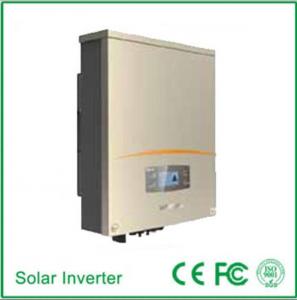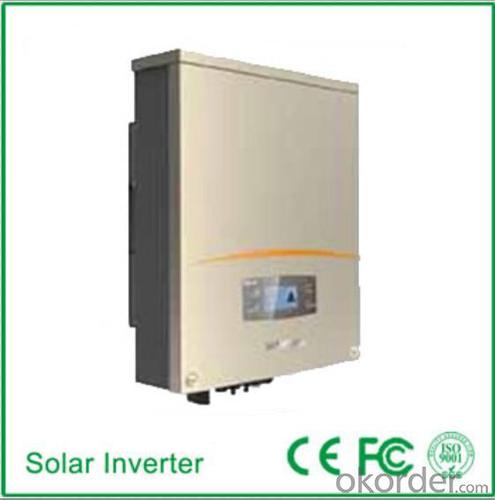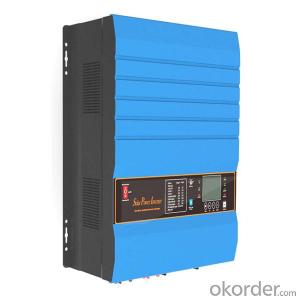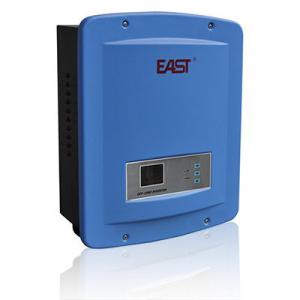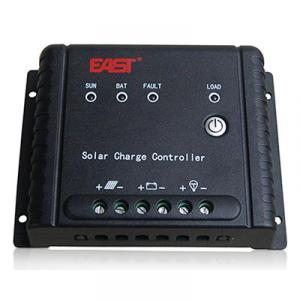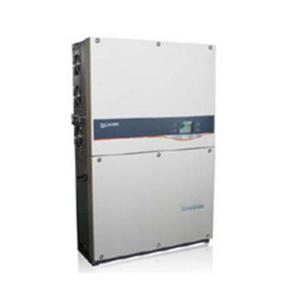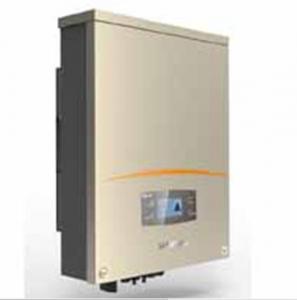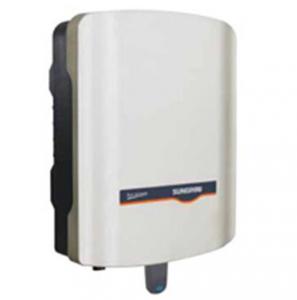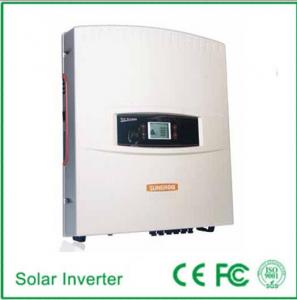Satcon Solar Inverter SG3KTL-EC
- Loading Port:
- China Main Port
- Payment Terms:
- TT or LC
- Min Order Qty:
- 50000 unit
- Supply Capability:
- 300000 unit/month
OKorder Service Pledge
OKorder Financial Service
You Might Also Like
1. Structure of Solar Photovoltaic Grid-Connected Inverter SG3KTL-EC Description
A solar inverter, or PV inverter, or Solar converter, converts the variable direct current (DC) output of a photovoltaic (PV) solar panel into a
utility frequency alternating current (AC) that can be fed into a commercial electrical grid or used by a local, off-grid electrical network. It is a
critical BOS–component in a photovoltaic system, allowing the use of ordinary AC-powered equipment. Solar inverters have special
functions adapted for use with photovoltaic arrays, including maximum power point tracking and anti-islanding protection.
2. Main Features of the Solar Photovoltaic Grid-Connected Inverter SG3KTL-EC
• Flexible design due to dual MPP tracking that is equipped to obtain full nominal power, 3-phase supply
• High energy yield due to maximum efficiency up to 98.1%
• Low noise levels and internal consumption due to natural cooling
• Integrated theft protection
• Access to Home WiFi system and enjoy cloud services via smart phones
• Integrated power management function, easy to receive the adjustable command from grid
• Extensive communication: RS-485, Ethernet, WLAN / WiFi, 4 digital inputs for ripple control receivers
• Product certification: TÜV, VDE 0126-1-1, EN 62109-1/-2, CE, G83/1, VDE-AR-N 4105
• Manufacturer certification: ISO 9001, ISO 14001, OHSAS 18000
3. Solar Photovoltaic Grid-Connected Inverter SG3KTL-EC Images
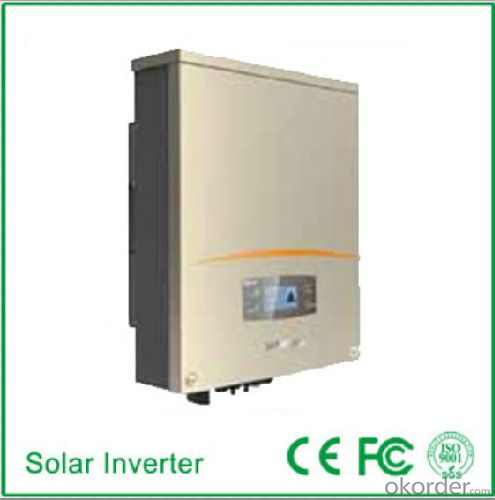
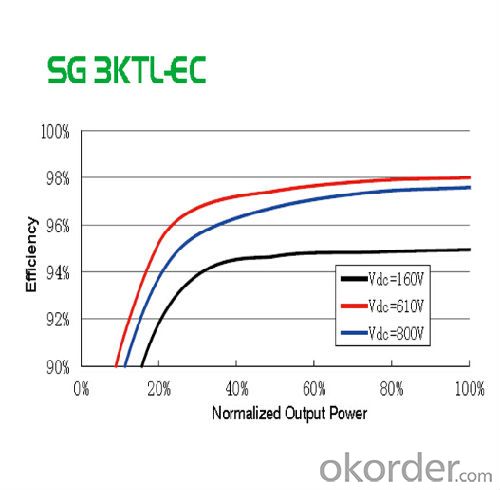

4. Solar Photovoltaic Grid-Connected Inverter SG3KTL-EC Specification
Input Side Data | |
Max. PV input power | 3191W |
Max. PV input voltage | 1000V |
Startup voltage | 200V |
Nominal input voltage | 610V |
MPP voltage range | 140~900V |
MPP voltage range for nominal power | 160~800V |
No. of MPPTs | 2 |
Max. number of PV strings per MPPT | 1/1 |
Max. PV input current | 19.8A(9.9A/9.9A) |
Max. current for input connector | 10A |
Short-circuit current of PV input | 24.8A(12.4A/12.4A) |
Output Side Data | |
Nominal AC output power | 3000W |
Max AC output power(PF=1) | 3000W |
Max. AC output apparent power | 3000VA |
Max. AC output current | 4.4A |
Nominal AC voltage | 3/N/PE,230/400Vac |
AC voltage range | 310~480Vac(May vary as per corresponding country's grid standard) |
Nominal grid frequency | 50Hz |
Grid frequency range | 45~55Hz |
THD | < 3 % (Nominal power) |
DC current injection | <0.5 %In |
Power factor | >0.99@default value at nominal power, |
Protection | |
Anti-islanding protection | Yes |
LVRT | No |
DC reverse connection protection | Yes |
AC short circuit protection | Yes |
Leakage current protection | Yes |
DC switch | Integrated |
DC fuse | No |
Overvoltage protection | III |
System Data | |
Max. efficiency | 98.0% |
Max. European efficiency | 96.0% |
Isolation method | Transformerless |
Ingress protection rating | IP65 |
Night power consumption | <1W |
Operating ambient temperature range | -25~60℃(>45℃ derating) |
Allowable relative humidity range | 0~100% |
Cooling method | Natural cooling |
Noise | ≤29dB |
Max. operating altitude | 2000m |
Display | Graphic LCD |
Communication | Ethernet,RS485(RJ45 connector), |
DC connection type | MC4 |
AC connection type | Plug and play connector |
Certification | VDE0126-1-1,EN62109-1,EN62109-2, |
Mechanical Data | |
Dimensions(W×H×D) | 403×518×190mm |
Mounting method | Wall bracket |
Weight | 22kg |
5. FAQ of Solar Photovoltaic Grid-Connected Inverter SG3KTL-EC
Q1. What is the difference between inverter and solar inverter?
A1. Inverter only has AC inpput, but solar inverter both connect to AC input and solar panel, it saves more power.
Q2. What is the difference between MPPT&PWM?
A2. MPPT has higher efficiency, it can track the max power point and won't waste energy.
- Q: How does MPPT technology work in solar inverters?
- MPPT (Maximum Power Point Tracking) technology in solar inverters works by continuously adjusting the operating voltage and current of the solar panels to ensure the maximum power output. It does this by constantly monitoring the voltage and current of the solar panels and finding the optimal point (maximum power point) at which the panels can deliver the most power. This is achieved by varying the load on the panels to match their impedance with the maximum power point. MPPT technology maximizes the efficiency of solar power generation by extracting the maximum available power from the panels under varying environmental conditions such as shading, temperature changes, and panel degradation.
- Q: Can a solar inverter be used with a solar car charging system?
- Yes, a solar inverter can be used with a solar car charging system. A solar inverter converts the direct current (DC) produced by solar panels into alternating current (AC) that can be used to charge electric vehicles, including solar cars. This allows the solar car charging system to efficiently convert and deliver the solar energy to charge the car's battery.
- Q: Can a solar inverter be used with batteries?
- Yes, a solar inverter can be used with batteries. In fact, using a solar inverter with batteries is a common practice in solar energy systems. The inverter helps convert the direct current (DC) electricity generated by the solar panels into alternating current (AC) electricity that can be used to power various appliances and devices. When batteries are connected to the system, the excess electricity generated by the solar panels can be stored in the batteries for later use, allowing for continuous power supply even when the sun is not shining.
- Q: What is the difference between a central inverter and a string inverter?
- A central inverter is a single large inverter that is responsible for converting the DC power generated by multiple solar panels into AC power for use in a building or to be fed back into the grid. On the other hand, a string inverter is a smaller inverter that is connected to a string of solar panels, typically between 6 to 20 panels, and converts the DC power generated by that specific string into AC power. The main difference is that a central inverter is used for larger solar installations, while string inverters are more commonly used in smaller residential or commercial installations.
- Q: Can a solar inverter be used with a solar-powered telecommunications system?
- Yes, a solar inverter can be used with a solar-powered telecommunications system. A solar inverter is an essential component of a solar-powered system as it converts the direct current (DC) generated by solar panels into alternating current (AC) that can be used to power various electrical devices, including telecommunications equipment. By using a solar inverter, the solar-generated electricity can be efficiently utilized to run a telecommunications system, making it a sustainable and environmentally-friendly solution.
- Q: Can a solar inverter work in low light conditions?
- No, a solar inverter requires sufficient sunlight to convert the DC power generated by solar panels into usable AC power. In low light conditions, the solar inverter's efficiency decreases, and it may not be able to generate the required amount of electricity.
- Q: Can a solar inverter be used in remote areas without access to the grid?
- Yes, a solar inverter can be used in remote areas without access to the grid. Solar inverters are designed to convert the direct current (DC) electricity generated by solar panels into alternating current (AC) electricity that can be used to power electrical appliances. In remote areas, solar panels can be installed to harness sunlight and convert it into electricity, which can then be used through the solar inverter to provide power to homes, businesses, or any other electrical devices without the need for a grid connection.
- Q: What is the role of a solar inverter in fault ride-through capability?
- The role of a solar inverter in fault ride-through capability is to help maintain the stability and reliability of the power grid during faults or disturbances. By detecting and responding to voltage and frequency variations caused by faults, the solar inverter can adjust its output and remain connected to the grid, ensuring continuous power supply. This capability is essential for grid stability and allows solar power systems to contribute to the overall reliability of the electrical network.
- Q: How does shading affect the performance of a solar inverter?
- Shading can significantly impact the performance of a solar inverter as it reduces the amount of sunlight reaching the solar panels. When panels are partially shaded, they generate less power, which in turn affects the output of the inverter. If a significant portion of the panels are shaded, the inverter may not be able to operate optimally or may even shut down. To overcome shading issues, technologies like bypass diodes or micro-inverters can be used, which minimize the impact of shading on overall system performance.
- Q: Can a solar inverter be used with a single solar panel?
- Yes, a solar inverter can be used with a single solar panel. The purpose of a solar inverter is to convert the direct current (DC) produced by the solar panel into alternating current (AC) that can be used to power electrical devices or be fed back into the grid. Whether you have one solar panel or multiple panels, a solar inverter is necessary to convert the DC electricity into usable AC electricity.
Send your message to us
Satcon Solar Inverter SG3KTL-EC
- Loading Port:
- China Main Port
- Payment Terms:
- TT or LC
- Min Order Qty:
- 50000 unit
- Supply Capability:
- 300000 unit/month
OKorder Service Pledge
OKorder Financial Service
Similar products
Hot products
Hot Searches
Related keywords
